Marilyn (CORAC’s Sustainable Living team lead) asked me to write something about the herbs that are ready for harvesting in many parts of the country (or hopefully will be ready in the Northern reaches soon). Herbs to look for now are dandelion, plantain (if you’re south of, say, Columbus OH or Indianapolis), nettles, violets, cleavers, chickweed, burdock, and purple deadnettles. Throughout the course of the day, I will send a blurb about each of these herbs, which part of the plant to harvest, and what you can do with it. I’ll start with violets.
Several species of violets are used medicinally. Around here, we have Viola odorata. Violets can be harvested throughout the year, but they are ready for harvest in early-to-mid spring in much of the country. The flowers, leaves, and stems can all be used medicinally. They are also edible and can be used raw or cooked. The easiest way to harvest them is to grab a handful and cut the stems with a hori hori or other long-ish garden knife. They can be tinctured fresh or dried (dried is easier), or they can be dried for use as a tea. You can dry them in an electric dehydrator, or simply by laying them flat in a single layer on a tray, in a shallow box or basket, or on a bedsheet spread on the floor of a spare bedroom. Violet tea or tincture is excellent for all sorts of respiratory ailments: sore throats, coughs, bronchitis, pneumonia, whooping cough, etc. And a syrup made of the leaves and/or flowers is a wonderful cough syrup. Violet also has other uses such as treating hives, cradle cap, and some oral cancers. Below are some pictures of the violets I harvested this morning just before it started to rain.

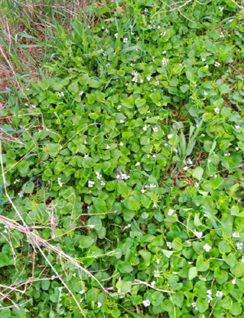
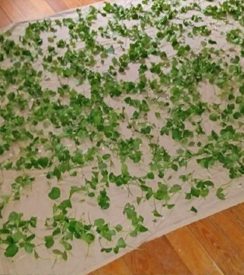
Violets
I’m not planning to leave the violets on the sheet; I’m just spreading them out for the dew to dry off of them. After that, I’ll put them on some dehydrator trays that I’ll stack up on my son’s desk in his room (hey, the school year is almost over, and he barely sits at the desk anyway).
Next: Dandelions. They can be harvested throughout the growing season. The buds, flowers, leaves, and roots are edible (the leaves are delicious cooked with milder greens such as pigweed, lambsquarters, kale, or collards); and the leaves, roots, and stems are used medicinally. Grabbing a handful of leaf and cutting the stems with a garden knife is a quick way to harvest.
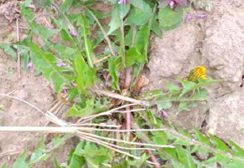
Dandelion
The flower stems can be eaten sparingly in order to do a spring “detox.” The latex from the flower stems is said to be good for dissolving warts when applied topically for several days. Dandelion leaf and root are good for the liver and gall bladder, and for detoxifying the body from all sorts of stuff. Dandelion leaf tea or tincture is very good for helping the body detoxify from spike proteins to which one has been exposed either through the vax or through shedding. Dandelion is a tonic herb and is safe for general consumption. But it is a diuretic; so if someone is taking pharmaceutical diuretics, they should probably not also take dandelion. Also, dandelion shouldn’t be taken too late in the day… the French don’t call it “pis-en-lit” (pee-the-bed) for nothing.
Plantain: Our plants are so small right now that I didn’t bother taking any pictures. But there are two types of plantain that are common in the US: broadleaf (Plantago major) and narrowleaf (Plantago lanceolata). There are medicinally interchangeable, but the broadleaf is more desirable simply because it gives you “more bang for your buck” (the leaves are a lot bigger, which means that collection and processing is a more
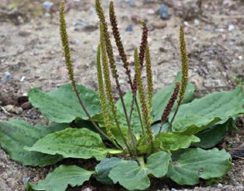
Plantain
efficient process). Also, narrowleaf plantain is easy to confuse with hawkweed. (If anyone is interested in figuring out how to tell the difference, I can explain it in another note). The leaves and seeds (psyllium) are the parts that are used medicinally fresh or dried, tea or tincture. Some people say that plantain is edible, but I’ve never been that hungry. One way to use plantain fresh is to make a “spit poultice” that can be applied to insect bites and stings: you chew up a leaf and then plaster it onto the bite or sting. It will draw out the toxin and relieve the pain and swelling. Plantain makes a great “drawing salve” or drawing poultice for bites, stings, splinters, and infection. It is useful to strengthen teeth against tooth decay. And if you can’t buy a multivitamin, it is excellent as a tea or tincture in combination with herbs like dandelion, violet, nettles, and alflafa. It’s good for so many things that I’d have to write a paper to go into them all. Check out Richo Cech’s book, or Joyce Wardwell’s book (The Herbal Home Remedy Book) for more details.
Nettles (Urtica dioica): Wear pants, long sleeves and gloves when harvesting these, because it will sting and burn anywhere that the leaves touch you even a little bit. Harvest the aerial parts of the plant before it goes to seed (after going to seed, the plants produce a substance that is not good for people to consume). If you harvest the leaves and stems when the plants are only 6-8 inches tall, you can harvest several times before the plants flower. Dry the stem and leaf entire, and then strip the leaves once the plants are dry. The books say that nettles lose their sting once they are dried. The books lied. Dried nettles are just as mean as the fresh ones; so wear pants, long sleeves, and gloves when stripping the dried leaves from the stems. Nettles can be made into tea or tincture. It is excellent

Stinging Nettle
for hay fever, whooping cough (mix with thyme, violet, and mullein if you have them), for pregnant women (it is full of vitamins and minerals), and nursing mothers (it promotes breastmilk production). Nettles can also be eaten as a cooked green; if you cook them, save the cooking water and drink it as a tea. (You wouldn’t do this with all greens that are cooked and then eaten. For instance, you would discard the cooking water for plants that are high in oxalic acid–such as lambs’ quarters or spinach–or high in goitrogens–such as cabbage, kale, and the other members of the cabbage family.). The tea and diluted tincture are also useful externally for cuts, wounds and burns. As always, see Cech and Wardwell for more information.
Chickweed (Stellaria media): This herb grows abundantly on our property, but I have never used it. It is both edible and medicinal. Supposedly it’s pretty tasty. The aerial parts are used, fresh or dried. Like plantain, it can be made into a drawing salve or drawing poultice. Some of the conditions for which it is useful are eczema, hives, arthritis, gout, hemorrhoids, gastritis, burns, ulcers, sore throats, asthma, bronchitis, and pleurisy. Hmmm… maybe I should harvest some this year…
Stinging nettle is Urtica dioica; purple deadnettle is Lamium purpureum. Stinging nettle is called that because it stings; purple deadnettle is called “dead” because, although the leaves look similar to those of stinging nettles, they do not sting. Both plants are ready for harvest in the spring. But they are easy to tell apart because purple deadnettle has pretty little
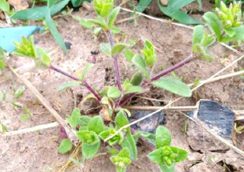

Chickweed
purple flowers and a purplish tinge to the upper leaves of the plant even during the early-to-mid spring; whereas stinging nettle has bland, inconspicuous flowers and doesn’t get purplish until much later in the season. Stinging nettle also grows several feet tall, whereas purple deadnettle tops out at about 12-18 inches (I’ve never seen it taller than a foot). Both plants are edible (although I can’t imagine eating the
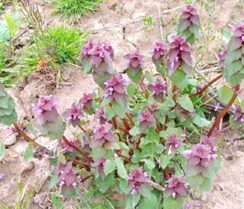
Purple Deadnet
deadnettle because I don’t like the way it smells); and both are excellent medicinals. But they are used very differently. One must be sure not to confuse purple deadnettle with a very similar-looking plant called henbit (which is easy to confuse with both purple deadnettle and ground ivy/creeping charlie. For a good article on the differences amongst the three, see https://unrulygardening.com/henbit-vs-purple-dead-nettle/) . Regarding the medicinal uses of purple deadnettle, here is the entry form Maud Grieve’s “A Modern Herbal: “The herb and flowers, either fresh or dried, have been used to make a decoction for checking any kind of haemorrhage. The leaves are also useful to staunch wounds, when bruised and outwardly applied. The dried herb, made into a tea and sweetened with honey, promotes perspiration and acts on the kidneys, being useful in cases of chill.” The aerial parts of the plant are harvested, and are used fresh or dried.
Burdock (Arctium lappa): Burdock leaves (when they’re young), stalks, and roots are all edible; and the leaves, seeds, and roots can be used medicinally (the seed tincture should not be used during pregnancy). The leaves and roots can be used as a drawing poultice for poisons/venom, splinters, infection, etc. It helps the body to detoxify. But it should be taken simultaneously with a diuretic herb such as dandelion; otherwise, burdock will cause the toxins to be eliminated from the body through the skin (and, therefore, pustules). A diuretic will allow the toxins to be eliminated through the urinary tract. Burdock is useful for conditions such
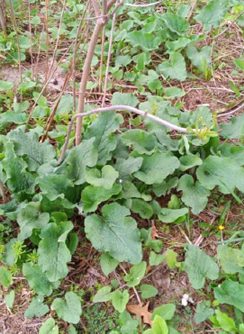
Burdock
as psoriasis and other skin problems, cysts, ulcers, measles and chickenpox, digestive problems, impetigo, staph infections, candida, and urinary tract infections. for medicinal purposes, both the leaf and root should be harvested in the first year; or in the spring of the second year, before the plant sends up its flower stalk. The leaves are used fresh; the root can be used fresh or dried; but the preferred use (for both tea- and tincture-making) is dried. Because the root contains a good bit of beneficial mucilage, one must be careful when straining the tincture so as not to strain out the mucilage with the rest of the solids. For that reason, this is one tincture that it might be worth making with cut-and-sifted dried root rather than with powdered root. season, so the seed pods don’t develop until well into the growing season (by which time we have usually stopped feeding burdock to the animals).
My husband thought I had lost my mind several years ago when I told him to stop killing the burdock that was growing in several parts of our property (back yard, side yard, edge of the garden, other places). He changed his mind when we had a drought a couple of summers later. The pasture was dead, and the sheep had eaten all the grass in the yard. But the burdock was green and lush and huge, so my husband started cutting it and feeding it to the sheep and goats. They loved it, and we loved the fact that the burdock grows back after it’s cut. That burdock really helped cut down on the amount of hay that we had to feed the animals that summer, and it made my husband a believer in the value of weeds vs. landscaping plants. I harvest the leaves even after the seed pods start to develop; the leaves will be a bit less nutritious that way, but the animals don’t seem to mind. But what often happens is that we cut the same plants a few times during the season, so the seed pods don’t develop until well into the growing season (by which time we have usually stopped feeding burdock to the animals).


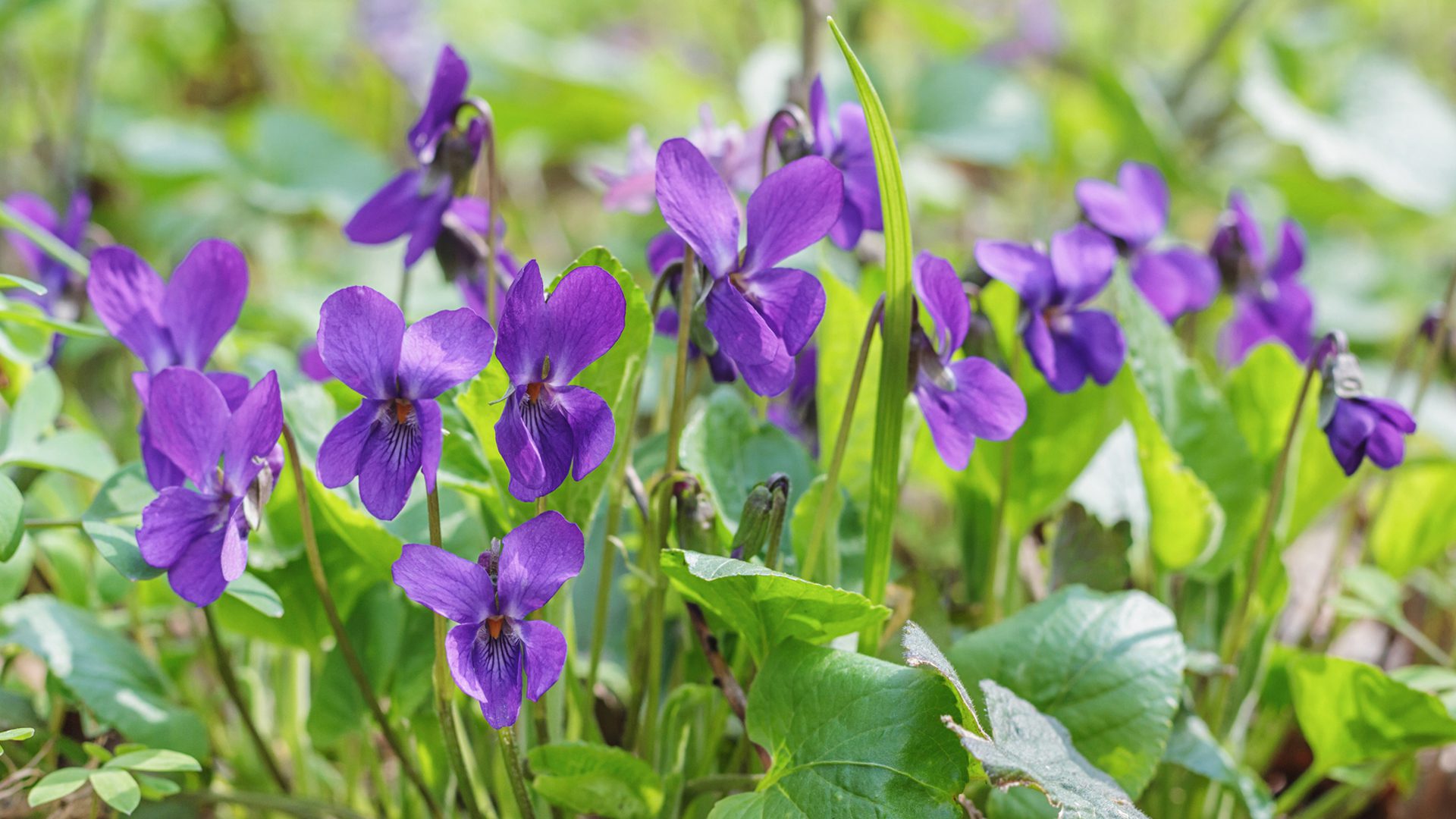








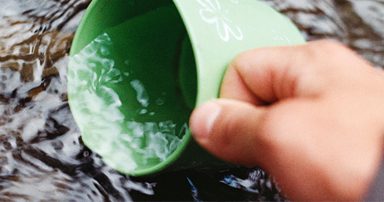









0 Comments